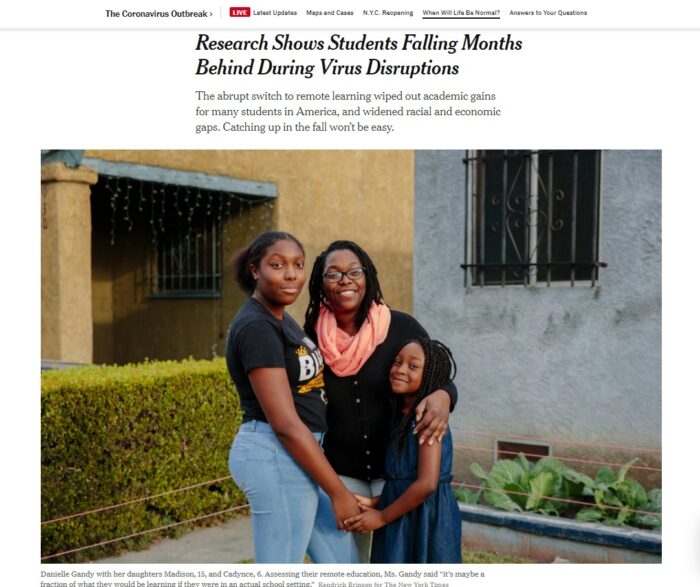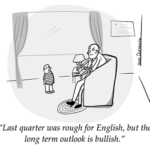Millions of kids didn’t participate in remote learning this spring. Why is the New York Times ignoring them?
For more than two and a half months, the nation’s schools were shut down, ostensibly replaced by something called “remote learning.” While frustrating and anxiety-producing for many teachers and parents, these programs failed to reach or engage millions of vulnerable kids in any meaningful way.
So when the New York Times published Research Shows Students Falling Months Behind During Virus Disruptions, on Friday, my initial reaction was to be hopeful. I’ve been wanting more coverage about the realities of remote learning from the Times. However, I was quickly disappointed. Instead of focusing on the lived experiences of these kids, the Times story skipped ahead to sketch out the likely outcomes of the remote learning mess, which include learning losses and tight budgets.
That’s too bad. And it’s part of a pattern. I haven’t seen nearly enough from the Times about what life has been like for the kids who haven’t been engaged by remote learning for an extended period of time. Then again, in-depth journalistic accounts of these kids’ experiences have been hard to find anywhere. I’ve met some of them in stories produced during the first few weeks of remote learning. I’ve seen glimpses of them in stories about special education and homeless students and English learners who are especially vulnerable — including in the Times. And I’ve read about them in surveys and stories about participation and attendance rates. But stories that put these kids front and center have been uncommon.
These kids are not dropouts. They’re not truants. They’re not statistics. They’re victims, and survivors — no less vulnerable and important than the kids who fled New Orleans or sheltered in place during Parkland. But in the Times, they have somehow become almost invisible. I can only imagine what the past 12 weeks have been like for them.
These kids are not dropouts. They’re not truants. They’re not statistics. They’re victims, and survivors — no less vulnerable and important than the kids who fled New Orleans or sheltered in place during Parkland. But in the Times, they have somehow become almost invisible.
Written by national education reporter Dana Goldstein, the Friday Times piece features the story of the Gandy family in Los Angeles, whose younger daughter has been participating in remote learning but not getting as much out of the lessons as she would have in real-life classrooms. It recounts the concerns of teachers, who acknowledge that remote learning hasn’t been enough. And it describes how, as a result of the inadequacies of this spring’s efforts, researchers found that students have lost progress they’d made and academic disparities have increased.
The piece also touches on the lack of instructional mandates and real teaching that has hampered remote efforts, the digital divide, and other factors — citing eye-popping research from CRPE showing that only a fifth of the districts studied have required live teaching over video.
Nominally focused on students who have been left behind by remote learning, the story does not feature any such students.
The sole national correspondent for the Times who covers K-12 education issues, Goldstein has written stand-alone pieces about various pieces of the remote learning puzzle in the past. She expresses an enormous amount of care and concern about these projected learning effects on these kids. But mentioning elements in passing or addressing them individually isn’t the same as centering the experiences of the students or, better yet, giving them voice.
According to Goldstein’s story, we are “a nation of burned-out, involuntary home schoolers slog[ging] to the finish line of a disrupted academic year.”
Well, that may be true for many. But clearly there are many others who have had a starkly different experience. And their experiences shouldn’t be downplayed or glossed over.
Related commentary: Remote learning has been a mess. Writing it off will only make things worse.

Above: Nominally focused on students who have been left behind by remote learning, the Times’ latest story does not feature any such students.
Under normal circumstances, a single mis-targeted story wouldn’t be worth more than a passing mention. But this isn’t the first time that the Times has danced around the uncomfortable core of the remote learning story. I fear it won’t be the last.
The paper’s editorial page has lamented the situation in extremely strong language, and reporter Nikita Stewart delivered a memorable feature early on about a homeless kid without a device or Internet access. However, the controversy-prone opinion section has run at least two op-eds raising questions about the need for urgency or action and the national and the metro NYC sections have taken a particularly strange, unhurried, and ad hoc approach to getting at the heart of the remote learning mess. There’s been no remote learning coverage focused on disengaged kids from Metro education reporter Eliza Shapiro since mid-April, if you look back at her stories. And the output from national education reporter Goldstein has generally avoided addressing the core failure of remote learning head-on, either.
Nikole Hannah-Jones’ viral Twitter thread about the lack of live instruction among many districts’ remote learning programs may be the strongest, most aggressive coverage of remote learning that we’ve seen from a Times reporter so far. For her efforts, she was swarmed by educators accusing her of “teacher-bashing.”
Nikole Hannah-Jones’ viral Twitter thread about the lack of live instruction among many districts’ remote learning programs may be the strongest, most aggressive coverage of remote learning that we’ve seen from a Times reporter so far.
What is going on at the Times is beyond my purview. Editors Scott Dodd and Dodai Stewart may think other education stories warrant more attention. And Goldstein and Shapiro and others may have stories to tell about pitches shot down, turf battles, or stories held up rather than published.*
However, Times education reporters have not been pulled off the beat to cover COVID-19 or the protests. Nor is the Times newsroom experiencing furloughs or layoffs. There’s no shortage of available talent for the Times to own the remote learning story, if the folks at the top of the masthead chose to deploy it.
Thus far, the overall amount and urgency of the coverage I’ve seen from the Times has just not been sufficient for the size and depth of the situation.
*Asked about remote learning coverage, the Times reporters I queried did not respond.

Above: What’s happened to kids like Malaiki Solo, who was profiled in an early Boston Globe story?
The Times isn’t alone in struggling to put the experiences of disengaged black and brown children front and center during this challenging time.
Where are all the profiles and investigations that center kids who have become disengaged from or abandoned by school systems? In-depth depictions of lonely, bored, scared kids for whom school effectively ended March 15 are hard to find.
Of course, it’s no simple task to find students whose families are no longer responding to teachers and school staff. But a handful of stories that have featured these vulnerable kids show it’s possible.
Though not focused on education, the Washington Post’s recent story about a struggling Florida family illustrates what can be done. And the coverage doesn’t have to be anything so elaborate to be effective. Early on, the Boston Globe found a 12 year old and had him livestream his day. It was brilliant. But what’s happened to him and other kids like him over the past two months? In my opinion, the story is worth the effort.
Remote learning failed a lot of kids. It probably didn’t have to be so bad. That’s why I keep calling for bigger, more comprehensive, and urgent pieces, giving us the full depth and scope of what happened, and providing a hard-nosed examination of the reasons behind the failures and whatever lessons that might emerge.
In the aftermath of other education crises like Hurricane Katrina and Parkland, the Times and other outlets produced amazing coverage that got to the core of what happened and put the kids most directly affected front and center. That’s what’s needed here.
Previous commentary: No, asking questions about remote learning isn’t ‘teacher bashing
ABOUT THE AUTHOR

Alexander Russo
Alexander Russo is founder and editor of The Grade, an award-winning effort to help improve media coverage of education issues. He’s also a Spencer Education Journalism Fellowship winner and a book author. You can reach him at @alexanderrusso.
Visit their website at: https://the-grade.org/












